|
Royal Park, Melbourne
Royal Park is the largest of Melbourne's inner city parks (). It is located north of the Melbourne CBD, in Victoria (Australia), Victoria, Australia, in the suburb of Parkville, Victoria, Parkville. Many sporting facilities are provided including the North Park Tennis Club, Royal Park Golf Course, football and soccer ovals, baseball and cricket Wiktionary:pitch#Noun, pitches, State Netball & Hockey Centre, and cycling and walking paths. On the corner of Gatehouse Street and Royal Parade, Melbourne, Royal Parade there is a native garden. There are wide vistas of grassland and lightly timbered areas with eucalypts, Casuarinaceae, casuarina, and acacias. The Melbourne City Council administers the park and instituted in 1984 a park management plan. A wetlands area was developed in 2005. The grassy hill between the Royal Children's Hospital, Melbourne, Royal Children's Hospital and the Native Garden is ideal for kite flying during the day. Over the summer months, members of the As ... [...More Info...] [...Related Items...] OR: [Wikipedia] [Google] [Baidu] |
Urban Park
An urban park or metropolitan park, also known as a city park, municipal park (North America), public park, public open space, or municipal gardens (United Kingdom, UK), is a park or botanical garden in cities, densely populated suburbia and other municipal corporation, incorporated places that offers open space reserve, green space and places for recreation to residents and visitors. Urban parks are generally Landscape architecture, landscaped by design, instead of lands left in their natural state. The design, operation and maintenance, repair and operations, maintenance is usually done by government agencies, typically on the local government, local level, but may occasionally be contracted out to a park conservancy, "friends of" group, or private sector company. Depending on size, budget, and land features, which varies considerably among individual parks, common features include playgrounds, gardens, hiking, running, fitness trails or paths, bridle paths, sports fields and c ... [...More Info...] [...Related Items...] OR: [Wikipedia] [Google] [Baidu] |
Melbourne City Council
The City of Melbourne is a local government area in Victoria, Australia, located in the central city area of Melbourne. In 2021, the city has an area of and had a population of 149,615. The city's motto is "''vires acquirit eundo''" which means "we gather strength as we go". The current Lord Mayor is Nicholas Reece, who replaced Sally Capp on 2 July 2024. The Melbourne City Council (MCC) holds office in Melbourne Town Hall. History 19th century Melbourne was founded in 1835, during the reign of King William IV, following the arrival of the schooner ''Enterprize'' near the present site of the Queen's Wharf. Unlike other Australian capital cities, Melbourne did not originate under official auspices, instead owing its origins to non-indigenous settlers from Tasmania. Having been a province of New South Wales from its establishment in 1835, affairs of the settlement had been administered by the Parliament of New South Wales. With the growth of the settlement there had b ... [...More Info...] [...Related Items...] OR: [Wikipedia] [Google] [Baidu] |
Red-rumped Parrot
The red-rumped parrot (''Psephotus haematonotus''), also known as the red-backed parrot or grass parrot, is a medium-sized broad-tailed parrot endemic to open woodland in south-eastern Australia, particularly in the Murray-Darling Basin. It is a highly sexually dimorphic species, with the adult female mainly being a greyish olive-green with lighter underparts and the adult male predominantly being a brightly coloured green and gold with various shades of blue on the wings. Only the adult male possesses the red rump that gives the species its common name. It is commonly found in open, grassy habitats, both in natural open woodland and in man-made environments such as paddocks, fields, parks and gardens. It has adapted well to rural and suburban areas and is commonly observed foraging on the ground for a variety of seeds. Taxonomy and naming The red-rumped parrot was described by John Gould in 1838 as ''Platycercus haematonotus'' from a specimen collected in New South Wales. He f ... [...More Info...] [...Related Items...] OR: [Wikipedia] [Google] [Baidu] |
Galah
The galah (; ''Eolophus roseicapilla''), less commonly known as the pink and grey cockatoo or rose-breasted cockatoo, is an Australian species of cockatoo and the only member of the genus ''Eolophus''. The galah is adapted to a wide variety of modified and unmodified habitats and is one of Australia's most abundant and widespread bird species. The species is endemic to mainland Australia. It was introduced species, introduced to Tasmania, where it is now widespread, in the mid-19th century and much more recently to New Zealand. Etymology The term galah is derived from ''gilaa'', a word from the Yuwaalaraay and neighbouring Australian Aboriginal languages, Aboriginal languages spoken in north-western New South Wales. Description The galah is about in length, and weighs . It has a pale silver to grey back, a pale grey rump, a pink face and breast, and a light pink mobile Crest (feathers), crest. It has a bone-coloured beak, and the bare skin of the eye ring is caruncle (bird an ... [...More Info...] [...Related Items...] OR: [Wikipedia] [Google] [Baidu] |
Australian Hobby
The Australian hobby (''Falco longipennis''), also known as the little falcon, is one of six Australian members of the family Falconidae. This predominantly diurnal bird of prey derives its name ‘''longipennis''’ from its long primary wing feathers. It occurs throughout Australia and other neighbouring countries with migrating individuals found on the islands of Indonesia and New Guinea.Debus, S. (1998). The birds of prey of Australia. Oxford University Press, Australia. Taxonomy The Australian hobby is a member of the family Falconidae and the order Falconiformes. Five major clades have been established in the genus ''Falco''. These include kestrels, merlins, hobbies, hierofalcons and peregrines. Hobbies are somewhat removed from these groups but are still a component of a more inclusive clade. Three subspecies of Australian hobby are usually recognised. These are: * ''Falco longipennis longipennis'', (Swainson, 1838) * ''Falco longipennis hanieli'' (Hellmayr, 1914) bein ... [...More Info...] [...Related Items...] OR: [Wikipedia] [Google] [Baidu] |
Horsfield's Bronze Cuckoo
Horsfield's bronze cuckoo (''Chalcites basalis'') is a small cuckoo in the family Cuculidae. Its size averages and is distinguished by its green and bronze iridescent colouring on its back and incomplete brown barring from neck to tail. Horsfield's bronze cuckoo can be distiguished from other bronze cuckoos by its white eyebrow and brown eye stripe. The Horsfield's bronze cuckoo is common throughout Australia preferring the drier open woodlands away from forested areas. This species was formerly placed in the genus '' Chrysococcyx''. Taxonomy The Horsfield's bronze cuckoo is one of five Australian species in the genus '' Chalcites'' (formerly '' Chrysococcyx'') a type of parasitic bird, that parasitizes fairy-wrens primarily to raise their young. Diet and behaviour The main diet of the Horsfield's bronze cuckoo is insects and they are nomadic, travelling to different regions of Australia to breed and find food. Small insects are taken from leaves, branches, caught on the wing ... [...More Info...] [...Related Items...] OR: [Wikipedia] [Google] [Baidu] |
Collared Sparrowhawk
The collared sparrowhawk (''Tachyspiza cirrocephala'') is a small, slim bird of prey in the family Accipitridae found in Australia, New Guinea and nearby smaller islands. It was formerly placed in the genus ''Accipiter''. As its name implies the collared sparrowhawk is a specialist in hunting small birds. It is characterised by its slight brow ridges and slender feet. The last segment of their middle toe projects beyond the claws of the other toes. Taxonomy The collared sparrowhawk was species description, formally described in 1817 by the French ornithologist Louis Pierre Vieillot, Louis Vieillot based on a specimen that had been collected in "Nouvelle-Hollande", now the state of New South Wales in eastern Australia. Vieillot coined the binomial name ''Sparvius cirrocephalus''. The specific epithet combines the Modern Latin ''cirrus'' or ''cirrhus'' meaning 'cloud' with the Latin ''cirrus'', ''cirri'' meaning 'ringlet'. This species was formerly placed in the genus ''Accipiter'' ... [...More Info...] [...Related Items...] OR: [Wikipedia] [Google] [Baidu] |
Brown Goshawk
The brown goshawk (''Tachyspiza fasciata'') is a medium-sized bird of prey in the family Accipitridae found in Australia and surrounding islands. This species was formerly placed in the genus ''Accipiter''. Taxonomy The brown goshawk was formally described in 1827 by the naturalists Nicholas Vigors and Thomas Horsfield under the binomial name ''Astur fasciatus''. The type locality is the state of New South Wales in eastern Australia. The brown goshawk was formerly placed in the genus ''Accipiter''. In 2024 a comprehensive molecular phylogenetic study of the Accipitridae confirmed earlier work that had shown that the genus was polyphyletic. To resolve the non-monophyly, ''Accipiter'' was divided into six genera. The genus '' Tachyspiza'' was resurrected to accommodate the brown goshawk together with 26 other species that had previously been placed in ''Accipiter''. The resurrected genus had been introduced in 1844 by the German naturalist Johann Jakob Kaup. The genus name com ... [...More Info...] [...Related Items...] OR: [Wikipedia] [Google] [Baidu] |
White-faced Heron
The white-faced heron (''Egretta novaehollandiae'') also known as the white-fronted heron, and incorrectly as the grey heron, or blue crane, is a common bird throughout most of Australasia, including New Guinea, the islands of Torres Strait, Indonesia, New Zealand, and all but the driest areas of Australia. It is a medium-sized heron, pale, slightly bluish-grey, with yellow legs and white facial markings. It can be found almost anywhere near shallow water, fresh or salt, and although it is prompt to depart the scene on long, slow-beating wings if disturbed, it will boldly raid suburban fish ponds. Taxonomy The white-faced heron was formally described in 1790 by the English ornithologist John Latham. He placed it with the herons in the genus '' Ardea'' and coined the binomial name ''Ardea novaehollandiae''. Latham based his account on the "white-fronted heron" that had been described and illustrated in 1789 by the first Governor of New South Wales Arthur Phillip in his book ''T ... [...More Info...] [...Related Items...] OR: [Wikipedia] [Google] [Baidu] |
Chestnut Teal
The chestnut teal (''Anas castanea'') is a dabbling duck found in Australia. It is protected under the National Parks and Wildlife Act 1974. Taxonomy The chestnut teal was described by the English naturalist Thomas Campbell Eyton in 1838 under the binomial name ''Mareca castanea''. The specific epithet ''castanea'' is from the Latin for "chestnut-coloured" or "chestnut-brown". A large molecular phylogentic study that compared mitochondrial DNA sequences from ducks, geese and swans in the family Anatidae found that the chestnut teal is a sister species to the Sunda teal (''Anas gibberifrons'') that is endemic to Indonesia. Description The chestnut teal is darker and a slightly bigger bird than the grey teal. The male has a distinctive green coloured head and mottled brown body. The female has a brown head and mottled brown body. The female is almost identical in appearance to the grey teal. The female chestnut teal has a loud penetrating "laughing" quack repeated rapidly nin ... [...More Info...] [...Related Items...] OR: [Wikipedia] [Google] [Baidu] |
Pacific Black Duck
The Pacific black duck (''Anas superciliosa''), commonly known as the PBD, is a dabbling duck found in much of Indonesia, New Guinea, Australia, New Zealand, and many islands in the southwestern Pacific, reaching to the Caroline Islands in the north and French Polynesia in the east. It is usually called the grey duck in New Zealand, where it is also known by its Māori name, . Taxonomy The Pacific black duck was Species description, formally described in 1789 by the German naturalist Johann Friedrich Gmelin in his revised and expanded edition of Carl Linnaeus's ''Systema Naturae''. He placed it with all the other ducks, geese and swans in the genus ''Anas'' and coined the binomial nomenclature, binomial name ''Anas superciliosa''. Gmelin based his description on the "Supercilious duck" that had been described in 1785 by the English ornithologist John Latham (ornithologist), John Latham in his ''A General Synopsis of Birds''. The naturalist Joseph Banks had provided Latham with a ... [...More Info...] [...Related Items...] OR: [Wikipedia] [Google] [Baidu] |







